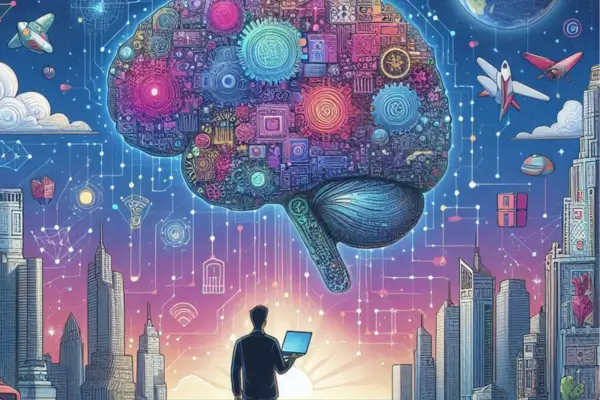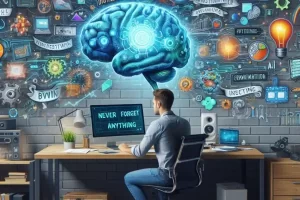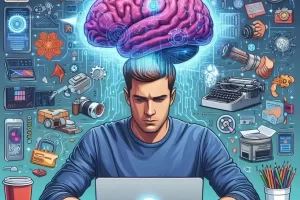Content creation can feel overwhelming — ideas get lost, drafts pile up, inspiration comes and goes, and publishing becomes inconsistent. But when you combine a second brain with artificial intelligence (AI), you unlock a system that captures every idea, develops it with ease, and helps you publish content faster, more consistently, and with higher quality.
In this article, you’ll learn how to build a content creation workflow inside your second brain that uses AI to support ideation, organization, writing, editing, and publishing.
Why Creators Need a Second Brain
Content creators — whether bloggers, YouTubers, writers, educators, or social media managers — deal with:
- Idea overwhelm
- Inconsistent publishing
- Forgotten drafts
- Burnout from constant creation
- Scattered notes and research
A second brain solves these by giving you:
- A central hub for all ideas and drafts
- A system to track progress from concept to publication
- A process to recycle and repurpose content
- Mental clarity and creative freedom
AI then becomes your creative partner, helping with:
- Brainstorming
- Outlining
- Writing
- Editing
- Repurposing
- Publishing strategies
Create a Content Pipeline
Build a pipeline in your second brain (Notion, Obsidian, or Tana) with stages like:
- 🔹 Idea
- 📝 Draft
- ✍️ In progress
- ✅ Edited
- 📅 Scheduled
- 🚀 Published
- ♻️ To repurpose
Each content piece flows through the stages. Use properties like:
- Topic
- Platform (Blog, YouTube, LinkedIn, etc.)
- Tags (Productivity, Marketing, Mindset)
- Publish date
- Status
- Link to published version
AI can help manage your pipeline:
“List all content in ‘Draft’ status that hasn’t been updated in 14 days.”
“Which ideas are ready to move into the writing stage?”
“Suggest 3 repurposing options for my last blog post.”
Capture and Develop Content Ideas Effortlessly
Every good piece of content starts as a quick thought. Use your second brain to collect ideas from:
- Book highlights
- Conversations
- Personal experiences
- Audience feedback
- Research or trends
Capture them using:
- Voice notes → Otter.ai
- Readwise for highlights
- Notion web clipper
- Quick capture templates
Ask AI:
“Expand this idea into a 3-paragraph draft.”
“What angle could I take on this idea that’s unique?”
“Summarize this research into key talking points.”
Now your ideas won’t get lost — and they’ll grow automatically.
Use AI to Generate Outlines and First Drafts
Writing doesn’t have to start with a blank page.
Prompts to try:
- “Create a blog outline from this idea and these notes.”
- “Write a 300-word rough draft using a conversational tone.”
- “Suggest 3 headline options for this post.”
- “Break this idea into a tweet thread.”
- “What’s a good story to introduce this topic?”
AI gives you a head start, so you spend less time stuck and more time polishing.
Build a Content Calendar and Publishing System
Use your second brain to map out a weekly, monthly, or quarterly publishing plan.
Create views by:
- Platform
- Publish date
- Category or goal
- Status (to write, ready, published)
Let AI assist:
“Suggest a 4-week content plan around productivity tips.”
“Which upcoming posts align with my goal to grow my newsletter?”
“Generate an Instagram caption based on this blog post.”
You’ll always know what’s coming next — and why it matters.
Edit and Refine With AI’s Help
Editing is where many creators get stuck. Let AI assist with:
- Grammar and tone suggestions
- Sentence improvement
- Clarity checks
- Style adjustments
- Rewriting for different audiences
Prompts:
“Make this more concise and punchy.”
“Edit this for clarity and flow.”
“Rewrite this section with a more persuasive tone.”
“Turn this formal paragraph into something friendly and casual.”
AI becomes your built-in editor — 24/7.
Repurpose and Reuse Content Automatically
Your best content shouldn’t live once and die.
Let AI help you:
- Turn blog posts into email newsletters
- Break articles into tweet threads
- Convert video transcripts into guides
- Pull quotes for social media
- Combine smaller pieces into ebooks or lead magnets
Prompts:
“Turn this post into a LinkedIn carousel outline.”
“What are 3 tweetable insights from this article?”
“Create a script for a 60-second video based on this idea.”
You don’t need to start from scratch — just reformat and relaunch.
Review and Improve Your Process
Set time to review your content system with AI’s support:
- What content performed best?
- Which ideas still need development?
- Where are you getting stuck?
- What topics are missing from your content mix?
Prompts:
“Summarize the content I published this month and identify patterns.”
“Which categories have been neglected recently?”
“What should I focus on next month based on engagement and reach?”
Your second brain + AI turns your workflow into a feedback loop for continuous improvement.
Real-Life Example: The Solo Creator’s Workflow
You’re a creator publishing weekly blog posts, YouTube videos, and newsletters.
Here’s how your second brain + AI works together:
- All ideas go into your “Content Vault”
- AI turns ideas into outlines, then drafts
- You track progress across a custom dashboard
- You use AI to create tweets, reels, and posts from your long-form content
- At the end of each month, AI reviews your content mix and audience feedback to guide your next plan
You’re not just creating more — you’re creating smarter and faster.
Final Thoughts: Build a System That Supports Your Creativity
Creativity thrives on structure. With a second brain and AI:
- Your ideas are captured and developed
- Your process becomes repeatable
- Your output becomes consistent
- Your content improves with less effort
You don’t need more time. You need a better system — one that works with you, grows with you, and helps you share your message with the world.
Let your second brain and AI handle the backend — so you can focus on what you do best: creating.
Quer que eu siga com o pró




